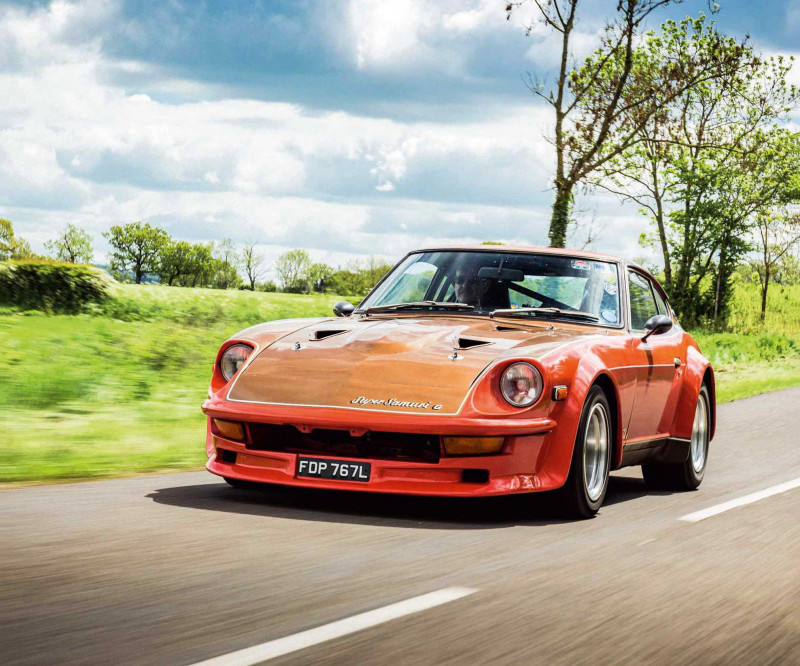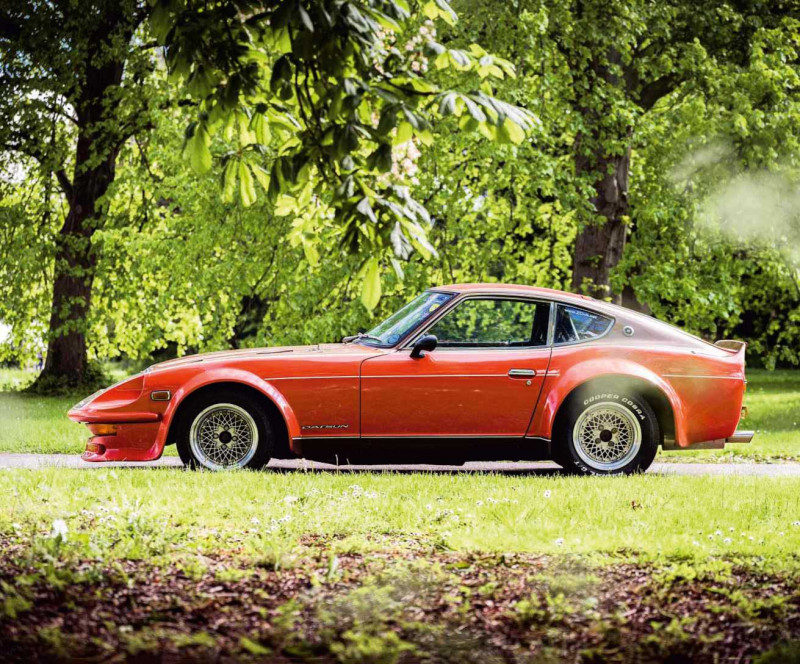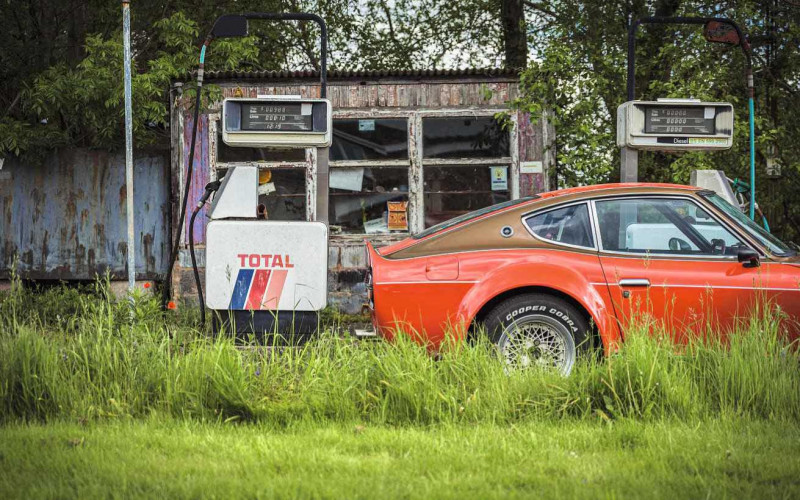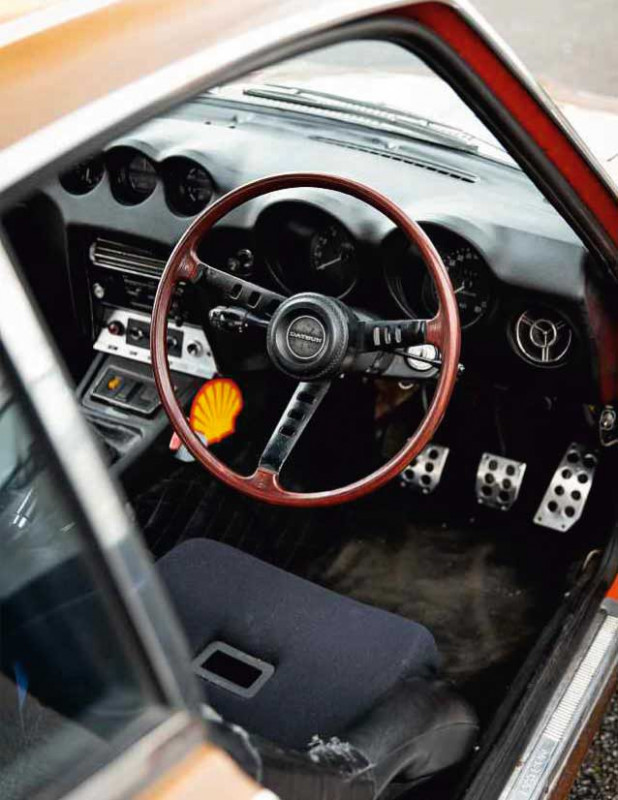1972 Datsun 240Z Super Samuri ‘Specification 3’
Legendary Datsun tuner Spike Anderson built only one ‘G-nose’ Super Samuri 240Z. Mark Dixon takes it on a tour of Anderson’s old haunts. Photography Reverend Pixel. Archive images courtesy of Spike Anderson.
AHEAD ВY A NOSE
DATSUN 240Z SUPER SAMURI
Visiting creator Spike Anderson’s old haunts in his ’70s road racer
Touring tuner Spike Anderson’s haunts
The world was very different 40 years ago. When Spike Anderson, who created the Super Samuri road and racing Datsun 240Zs, married his second wife Clara in October 1981, he was given an appropriate send-off from the Register Office.

‘There were eight Super Samuris parked outside, and the ensuing race to the reception, some 15 miles away, was nothing short of bloody dangerous,’ he recalled in his autobiography. ‘Someone from the [Silverstone] circuit was standing at the Daventry junction on the A5 and, having witnessed this, reckoned it was more spectacular than a Modsport race. As a matter of record, Ron Collins, in his G-nose Super Samuri, was declared the winner.’
So our feature car does have race history, of a sort. Collins was a Bedfordshire farmer and an Austin-Healey racer who commissioned this one-off Super Samuri — the only example from 74 cars built that features the longer ‘G-nose’ fitted to rare Nissan 240ZG variants — and became a good friend to Anderson.
‘He did like his drink, did Ron,’ says Spike Anderson down the phone from Spain, where he has lived for 28 years. ‘He was a very sociable character who could often be found in the Silverstone Clubhouse bar. One night he reckoned he’d had a bit too much to drink and had better go home, so he set off in the G-nose. The next thing he knew, he’d arrived back at the Silverstone Clubhouse, so he thought, I’d better have another drink...’

No-one would condone such behaviour today, of course, but the past is another country, and if anyone epitomises the devil-take-the-hindmost spirit of those years it’s Michael Richard ‘Spike’ Anderson. His autobiography Samuri, the Ultimate Evolution of the Datsun 240Z, co-authored with Octane contributor Paul Hardiman, is full of death-defying escapades, yet Anderson assures me that it barely scratches the surface.
As his book’s subhead implies, Anderson is most famous for building the modified Datsun 240Zs that he dubbed ‘Super Samuri’, a project that evolved out of his skill for improving cylinder heads of all kinds. He ported-and-polished literally thousands of them over the decades, having begun his career in 1970 at Broadspeed under the guiding hand of Ralph Broad. He soon got itchy feet, however, and after turning down a jobat BRM to rework the heads on the V12 F1 engine, he set up in business on his own, trading as Race Head Services.
Anderson moved just down the road from Broadspeed to the village of Harbury, not far from Leamington Spa — so that’s where I’ve arranged to meet Paul Matts, the owner of Ron Collins’ old car. We’re going to embark on a mini road-trip visiting Anderson’s old haunts, to see whether any traces of them remain, and drive the same roads on which Anderson put his conversions to the test. Harbury is where he built the first Super Samuri, registered FFA 196L, which kickstarted his business after journalist Clive Richardson road-tested it for Motor Sport and Motoring News in July 1973.

Why the unusual name? Because, says Anderson, a Japanese radio manufacturer was already using the Samurai trademark, and because neither he nor his signwriter were sure of the spelling! the first Samuri was a year-old Datsun Sunny 1200 coupe that Anderson had tricked up in 1972 with a modified cylinder head, twin SUs, straight-through exhaust, lowered suspension and a fancy paint job. But Anderson had already seen the potential of the 240Z, and bought FFA 196L brand new to carry out similar mods, albeit with triple Webers for carburation and a distinctive orange/bronze livery.
Almost as soon as the magazine road tests appeared, Anderson’s phone started ringing and by October the same year he’d already done ten Super Samuri conversions and changed the company name to Samuri.
A further boost came when an up-and-coming driver called Win Percy phoned to ask Spike if he could build him a Super Samuri for hillclimbing and road use. Anderson was very impressed with Percy’s ability as a driver and, when he subsequently built a 240Z for Modsports that he dubbed ‘Big Sam’, he asked Percy to race it. It led to an epic battle in the 1974 Modsports series that saw Big Sam and ‘FFA’, Anderson’s own car, taking it to the wire against the AFN Porsches: Win Percy scored the class championship by a single point.
Anderson’s premises were on Dovehouse Lane, Harbury, where he was on good terms with the local village bobby (whose first name was, coincidentally, Percy). ‘Old Percy was magic! He was a retired Preston motorway cop, who’d seen it all, and he became a regular visitor and consumed gallons of my coffee.

‘On the road from Harbury down to the Southam/Leamington road there was a lovely high-speed double chicane and, by using the whole road, I could get through it without dropping below 100mph. Fairly early one morning in “FFA” I was halfway through executing this manoeuvre when, to my horror, there was Percy on his police-issue 250cc BSA coming the other way… To this day I don’t know how I missed him.
‘Next morning he asked me where I had been going in such a hurry the previous day. “Banbury”, I told him. “My God,” he said, “Doesn’t that Datsun handle!” And that’s all he had to say on the matter.’
Sadly, there’s no trace of Anderson’s old workshops any more on Dovehouse Lane, where new housing occupies the site. So we head off to our next waypoint on the Spike Anderson heritage trail, the village of Croughton in Northamptonshire, today most famous for hosting the RAF/USAF Croughton airbase. Paul Matts is at the wheel of his G-nose and, since we’re travelling at rather less than Spike-speed, there’s time to ask him a little about how he came to acquire the car.

‘I bought it on eBay with a colleague from work!’ he replies, ‘this was back in 2006 and we paid just £6500 for it; later I bought my friend’s share out. Most of the paint is still original, so there are traces of cracking and crazing here and there, but I rather like that. Mechanically it’s as Spike built it to road-racer spec although I’ve plumbed in an extinguisher system after a couple of scary engine-bay fires, and fitted a “cold box” air intake in front of the open-trumpet Dell’Ortos. It’s now done 124,000 miles and on a recent dyno test recorded 209bhp at 5700rpm and 195lb ft at 5500; peak power would be even higher but the tester was unwilling to rev it any harder, although Spike claims it’s safe up to 7000rpm...’
We reach the village of Croughton, to where Anderson moved in 1976 after brief spells working at a mate’s premises in Bedfordshire and an even briefer second stint in Harbury. here’s no trace of his Croughton workshop now but, fortunately, the village still has a proper old- school tackle-anything garage (Horwell Auto Services) and the helpful proprietor Mick reckons that today it’s the site of the local Co-op.
Croughton also happens to be on my route from home to the old Octane office, so I’m very familiar with the roads that featured in many of Anderson’s hair-raising adventures. Going east, the main road through the village becomes the A421 after it crosses the A43 dual carriageway, and it’s still a fast, flowing piece of tarmac.
In his book, Anderson describes how he demonstrated ‘FFA’ to Croughtons local policeman, who was clearly angling for a ride. ‘I drove at exactly 50mph and, having crossed the roundabout, he said “OK, I’ll take my hat off now and you can show me what it can really do.”
‘the road was virtually straight for three miles and so I opened her up and reached about 150mph before having to slow down, turn round and return to Croughton. He thanked me profusely, jumped into his Panda and left, the following day I was very amused to hear that he’d been telling everyone in the village pub that he’d been out in the Datsun and done 150mph down the Finmere straight. Here, I thought to myself, was a policeman that was very unlikely ever to do me for speeding, they don’t make them like that anymore.’

Our last port of call in Paul Matts’ G-nose is going to be Silverstone, where Anderson rented a workshop from October 1979 — his last place before he decamped to Spain in 1993. Matts actually met Anderson during his last couple of years here, when he took his first 240Z (bright red, bought when he was 26) to have the head gasket changed. ‘For cash, of course!’ he says with a grin.
And now he kindly offers me the wheel. First, though, there is the minor problem of how to get into the hot seat. A combination of competition bucket and low-set wheel means that you have to stick your left leg in, wriggle your torso between seat and wheel, then drag your right leg over and under — all before fighting with the straps of the race harness. As Matts says, you don’t so much sit in as lie down in it. Once in, however, the view out back isn’t too bad, despite the tiny ear-shaped door mirrors.
Already it feels an exciting place to be, with that deep- dished wheel and heavily cowled instruments — and that’s before you fire up the straight-six. Wow! Immediately it’s clear that this is going to be the heart of it all: a snarling, track-focused powerplant that has no time for chugging along and comes alive only when the rev-counter needle is soaring past 4500rpm.
Even just pulling away, you need quite a few revs to avoid getting bogged down, but once you’ve seized the car by the scruff of its neck and learnt not to be afraid of using the throttle, it simply flies, here’s a delicious, hard-edged blare to the exhaust that just builds and builds as you head towards 6000rpm, and the dead-on seven-sec 0-60mph time that Clive Richardson recorded with ‘FFA’ in 1973 sounds absolutely feasible; in fact, Anderson built this G-nose with a 2.8-litre L28 block, so you could probably knock half a second or more off that. Back in 1973, Anderson was claiming only a 140mph top speed, but Richardson reckoned that 140 was a conservative estimate and that 150mph was quite realistic.
The A43 around Brackley has been turned into a dual carriageway since Anderson’s day and, as I sit at the traffic lights, a Saab hares up behind me, its driver beaming and giving a big thumbs-up. He clearly recognises and appreciates the car so, as the lights change, I slip into ‘Anderson mode’ and give it the full beans off the line, the tail squats slightly, the fat rear tyres grip and we rocket away to the glorious soaring song of that straight-six.

Up to the next roundabout — exactly where, 40 years ago, in usual flat-out fashion, Anderson passed another one of his policeman mates, parked in a layby with his sergeant in an llOOcc Escort panda car, and who on being instructed to give chase told his sergeant ‘not to be so daft’ — and the Sam’ scythes round with inch-perfect precision. It feels totally neutral, the steering perfectly weighted; it’s a car you feel instantly comfortable with, mentally if not initially physically.
OK, I’m exaggerating about the bucket seat… the G-nose is actually remarkably civilised as a road car, with very acceptable damping and a decent ride. Paul
Matts reckons it can tramline to some degree on poorer road surfaces but on this well-surfaced dual carriageway it feels just fine, the five-speed gearbox needs a bit of finessing, mind: get too carried away with the spirit of the moment and you can miss a slot. Easy, tiger.
Silverstone Circuit has changed more than any other place we’ve visited today, of course, and the old WW2 buildings where Anderson had his workshop — his was the old ‘bomb store’ — are long gone. But it’s an appropriate place to end our pilgrimage, since it marked the end of a long phase in Anderson’s life and career, too. Plagued by the taxman, no longer able to pay the rent on his workshop, he wound up Samuri and moved to Spain with his wife Clara, where he has lived ever since.
Cars have never totally left his life, of course — he’s built one or two specials over there — but his main interest in retirement has been continuing his lifelong parallel career as a jazz horn player, something he’s about to resume after a Covid-enforced lay-off. Anderson has never had much money and has frequently lived close to the bread-line, but he has no regrets.
‘I have a theory that if you can look back at your life and it makes you smile, you’ve got nothing to grumble about,’ he reflects wryly. ‘And there’s been lots in my life not only to make me smile but to have a bloody good laugh at.’
Above Silverstone is where Octane's journey comes to an end — as did Spike’s; frequent run-ins with the taxman forced him to give up his workshop here and move to Spain in 1993.
‘THE SNARLING POWERPLANT COMES ALIVE WHEN THE REV-COUNTER NEEDLE IS SOARING PAST 4500RPM’
Clockwise, from right Wheels are period Enkei alloys; lack of rear bumper accentuates Kamm tail; a 240Z-powered Datsun 1200 Samuri Sukati at Silverstone; harnesses and seats in G-nose.
1972 Datsun 240Z Super Samuri ‘Specification 3’
- Engine 2753cc straight-six, works rally camshaft, modified big-valve head, three Dell’Orto 40 DCOE carburettors, big-bore exhaust manifold and system, oil cooler
- Max Power 209bhp @ 5700rpm
- Max Torque 195lb ft @ 5500rpm
- Transmission Five-speed manual, rear-wheel drive
- Steering Rack and pinion
- Suspension MacPherson struts with uprated coil springs, lower wishbones, front anti-roll bar
- Brakes Four-pot vented discs
- Weight c1050kg
- Top speed 150mph (est)
- 0-60mph 6.5sec (est this car)
'THE SNARLING POWERPLANT GOMES ALIVE WHEN THE REV-GOUNTER NEEDLE IS SOARING PAST 4500RPM'
Clockwise, from above Long ‘G-nose’ was unique to this Super Samuri; Dovehouse Lane was the site of Spike Anderson’s first workshop; the man himself with his first 240Z, ‘FFA 196L’.
Above Spike Anderson could never have afforded to live at Croughton House — but today’s owners kindly allowed Octane to pose the Datsun there.


